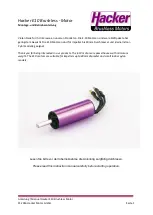
18
Adjust the needle-valve
10.
Abrupt adjustment of the needle-valve may cause the
engine to stop, especially when it is new and insufficiently
run-in.
As the speed of the engine does not instantly change with
needle-valve readjustment, small movements, with pauses
between, are necessary to arrive at the optimum setting.
Practical best (optimum) needle-valve setting
Fig.27
Approx. 40
Maximum rpm setting
("Lean")
"Rich" needle-valbe setting
when starting the engine.
Rpm starts to decrease.
Close the needle-valve
gradually and slowly.
Engine stops.
Re-starting the engine when warm
To re-start the engine when warm, simply re-energise the
plugs and reapply the starter with the throttle in the idling
position. If the engine does not start, disconnect the battery
from the glowplugs and re-prime by closing the choke valve
while rotating the propeller twice with the throttle open.
Initially, the high temperature inside the combustion chambers
may turn the liquid fuel into gas and emit it through the
exhaust pipes. Therefore, repeat the priming procedure once
or twice until the cylinders become cool enough for restarting.
RUNNING-IN ("Breaking-in")
Obtain an 18x12 or 20x8 propeller for running-in.
↓
↓
1
2
1. Running-in on the ground
Start the engine
Set the needle-valve at 500-1,000r.p.m. lower than
maximum r.p.m. setting and run approx, 10 seconds.
(It is suggested to use a tachometer.)
Open the needle-valve at approx. 1,000r.p.m. lower
than above setting and run approx. 20 seconds.
Repeat above procedure, i.e., richening and leaning the
mixture until the engine has approx. 10 minutes of running
time.
Keep the throttle fully open, using only the needle-valve to
change r.p.m. Prolonged running-in on the ground is not
suggested because the purpose is just initial running-in
to increace engine temperature gradually close to that of
maximam r.p.m.
NOTE:
19
2. Running-in in the air
Start the engine
Set the needle-valve approx 40 open from
optimum position (approx. 40 open from
maximum r.p.m.).
Fly the model.
NOTE: Avoid prolonged heavy load flight.
With each successive flight, close the needle-valve slightly,
until, at the end of 10 flights, the needle-valve is set for
optimum position.
Finish running-in.
The carburetor can now be adjusted for optimum throttle
performance following the instructions given in the next
section.
THROTTLE VALVE ADJUSTMENT
Photo. 5
Needle-valve
Fuel inlet
Choke valve
Mixture control screw
Throttle stop screw
Needle-valve adjustment
Adjust the needle-valve following the instructions given in
STARTING section.
Mixture control valve adjustment
After running is completed and the needle-valve is set at
optimum position (approx 40 open from maximum r.p.m.
position), check the idle speed and adjust only when
necessary.
Throttle lever
The carburetor of your FF-320 has been factory set for the
approximate best result with the fuel tank located in the normal
position (i.e. close to the back of the engine and where the
level of the needle-valve is at 1/3 height of the tank), but the
setting may, in some cases, vary slightly in accordance with
fuel and climatic conditions.
Fig.28
approx. 1/3
Level of needle-valve



































